
HMS Dwarf was launched in 1840 as the mercantile Mermaid. The Royal Navy purchased her in 1843 as the Navy's first screw-propelled vessel. She was broken up in 1853.

HMS Dwarf was launched in 1840 as the mercantile Mermaid. The Royal Navy purchased her in 1843 as the Navy's first screw-propelled vessel. She was broken up in 1853.
Mermaid was an iron vessel built at Blackwall for mercantile use. She was fitted with Bennet Woodcroft's patent varying pitch screw propeller. [1]
She was of 164 tons, and her mean draught on her trial trip was only 5+1⁄2 feet (1.7 m). [2]
The British Admiralty purchased Mermaid from J. and G. Rennie, Holland Street, Blackfriars, on 22 June 1843, [3] [4] according to Sir George Cockburn's advice, and on the condition that she should steam 12 miles per hour (19 km/h) (7 March 1842). The Navy renamed her HMS Dwarf.
Dwarf underwent trials on 15 May 1843. Over six runs she achieved a mean speed of 12.142 miles. [5] The results of her extensive propeller trials were published in December 1844. [6]
Dwarf went on to serve as a tender to HMY Victoria and Albert (1843), she was under the command of Lieutenant Commander Edward Halhead Beauchamp-Proctor [7] until March 1843, when the vessel was paid off at Woolwich. [3]
Prince Albert while on board HMY Victoria and Albert at Cowes in October 1844 professed interest in the little screw and came on board with Queen Victoria for a closer look. [8]

In December 1845, Dwarf was sent to Sheerness to take on the duties of that port's admirals' tender. [3]
Lieutenant Osborne, when in command of Dwarf on the coast of Ireland in 1848, fitting out in the Portsmouth Basin, heard the cry of "a boy overboard," he immediately plunged in with his full uniform on, including his sword, and saved the boy. A first-class certificate was awarded, and he was strongly recommended to the Parent Society in London. [9]
Dwarf, while moored in Kingstown Harbour, Ireland, sent an armed boat's crew to Ann Kenney and captured an unrecognised emerald silk flag. [10]
On 26 September 1849, she was run down by and collided with HMS Trident in the Atlantic Ocean 60 nautical miles (110 km) southeast of the Old Head of Kinsale, County Cork. Dwarf was severely damaged. Her crew were taken off by Trident, which towed her into Kinsale, County Cork for repairs. [11]
Dwarf was scrapped in 1853. [3]
The second screw vessel in the Royal Navy was HMS Bee a paddle vessel, built of wood and launched in 1842 as a tender to the Royal Academy, Portsmouth. Bee had additional screw propulsion fitted in 1844. She was broken up in 1874. Both vessels were purely experimental and never intended for active service. [12]
Capture of an Irish Flag. The Ann Kenney, now lying in the river, receiving passengers for Quebec, had a gaudy-looking green ensign flying from her topmast, with a union on one corner, and a harp, without a crown, on the field of the flag. An officer from HMS the Dwarf, with a boat's crew, armed, proceeded on board the Ann Kenney, and made capture of the unrecognised emerald silk. Waterford Mail.
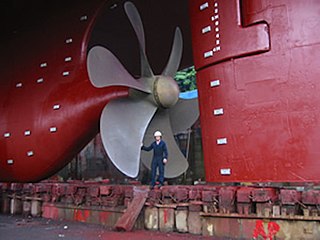
A propeller, is a device with a rotating hub and radiating blades that are set at a pitch to form a helical spiral, that, when rotated, exerts linear thrust upon a working fluid, such as water or air. Propellers are used to pump fluid through a pipe or duct, or to create thrust to propel a boat through water or an aircraft through air. The blades are specially shaped so that their rotational motion through the fluid causes a pressure difference between the two surfaces of the blade by Bernoulli's principle which exerts force on the fluid. Most marine propellers are screw propellers with helical blades rotating on a propeller shaft with an approximately horizontal axis.

Steam frigates, the larger steam ships of the line and the smaller steam corvettes, steam sloops, steam gunboats and steam schooners, were steam-powered warships that were not meant to stand in the line of battle. The first such ships were paddle steamers. Later on the invention of screw propulsion enabled construction of steam-powered versions of the traditional ships of the line, frigates, corvettes, sloops and gunboats.
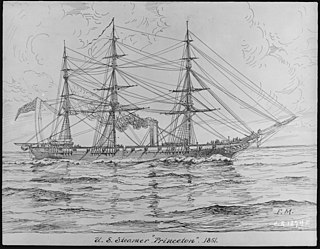
The first USS Princeton was a screw steam warship of the United States Navy. Commanded by Captain Robert F. Stockton, Princeton was launched on September 5, 1843.
Three vessels and two shore establishments of the Royal Navy have been named HMS Bee, after the insect, the bee. A third ship was ordered but never completed:
Eight ships and a shore establishment of the Royal Navy have borne the name HMS Vulcan, after the god Vulcan, of Roman mythology:
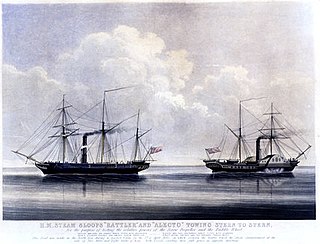
HMS Rattler was a 9-gun steam screw sloop of the Royal Navy, and one of the first British warship to be completed with screw propulsion. She was originally ordered as a paddle wheel 4-gun steam vessel from Sheerness Dockyard on 12 March 1841. She was reordered on 24 February 1842 as a propeller type 9-gun sloop from HM Royal Dockyard, Sheerness as a new vessel. Sir William Symonds had redesigned the ship as a screw propeller driven vessel.
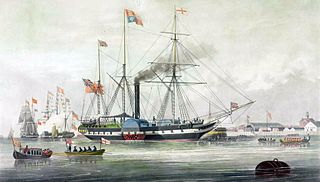
HMS Trident was an iron paddle sloop built for the Royal Navy by Ditchburn & Mare in 1845 at Leamouth, London. She served in the Mediterranean, off West Africa and in the South Atlantic, and was broken up in 1866.

The third HMS Dauntless was a wooden-hulled steam screw frigate, launched at Portsmouth in 1847.

HMS Sans Pareil was a 70-gun screw propelled ship of the line of the Royal Navy.
J. and G. Rennie was a British engineering company based in Millwall, London, England. They were involved in manufacture of marine engines, and some complete ships, as well as other diverse onshore engineering projects. An association with railway engines is usually attributed to G. and J. Rennie, which may suggest they used a second company to keep the books separate, and there was also George Rennie & Sons, which is associated with the development and patents of the steam disc engine. All three companies appear to have been in existence at the same time.

SS Archimedes was a steamship built in Britain in 1839. She was the world's first steamship to be driven successfully by a screw propeller.

HMS Niger was originally slated to be built as a Sampson designed sloop; however, she was ordered as a First-Class sloop with screw propulsion on 20 February 1845 to be built at Woolwich Dockyard, along the design developed by Oliver Lang and with a hull like the Basilisk designed paddle sloops. Her armament and engine were to be like the Encounter Design building at Pembroke. A second vessel (Florentia) was ordered on 26 March 1846 but after her keel was laid at Pembroke Dockyard, her construction was suspended on 6 October 1846 then cancelled three years later, on 22 May 1849. Niger She conducted important propulsion trials, finally proving the superiority of screw propulsion and served in West Africa, the Crimea, China, the East Indies and Australia. She took part in the New Zealand wars in 1860 and was sold for breaking in 1869.
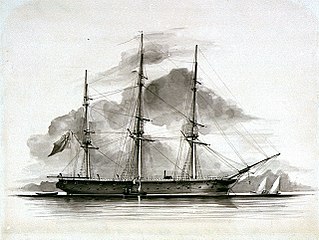
HMS Brisk was a 14-gun wooden-hulled screw sloop designed by the Committee of Reference as part of the 1847 program. She is considered an enlarged Rattler with the design approved in 1847. She was ordered on 25 April 1847 from Woolwich Dockyard as a 10-gun sloop, but the guns were later increased due to the Russian War, to 14 guns by increasing the number of 32-pounder guns. She was launched on 2 June 1851 from Woolwich Dockyard. She served in the Russian War of 1854- 55 and as part of the West African anti-slavery patrol, with a final commission on the Australian Station. She was sold in 1870 into mercantile service.

Admiral Sir Arthur Cumming was an officer of the Royal Navy.

HMS Phoenix was a 6-gun steam paddle vessel of the Royal Navy, built in a dry dock at Chatham in 1832. She was reclassified as a second-class paddle sloop before being rebuilt as a 10-gun screw sloop in 1844–45. She was fitted as an Arctic storeship in 1851 and sold for breaking in 1864.

HMS Reynard was part of the 1847 Program, she was ordered on 25 April as a steam schooner from Deptford Dockyard with the name ‘Plumper’. However, the reference Ships of the Royal Navy, by J.J. College, © 2020, there is no entry that associates the name Plumper to this build. The vessel was reordered on August 12th as an 8-gun sloop as designed by John Edye. She was launched in 1848, conducted anti-piracy work in Chinese waters and was wrecked near Pratas Island in the South China Sea on 31 May 1851.

HMS Simoom was an iron frigate converted to an iron screw troopship. She was laid down in October 1845; however, on 23 April 1847 her frigate design was abandoned as this type of iron warship was considered to be unsuitable against cannon fire and she was ordered to be completed as a troopship. She was launched by Robert Napier and Sons in Govan, Yard No 17, on 24 May 1849, then sold to Collings, Dartmouth in June 1887.

HMS Penelope was first laid down as one of the many sail frigates that England built to a French model. She was then changed to a unique steam paddle frigate. For some time she was a very famous ship, having a claim to being the first steam frigate. In the end the promise that she would be the first of a line of true steam paddle frigates proved false.
Seven vessels of the Royal Navy have been named Dwarf:
The recent trials of H.M. Steamer Dwarf having been made with the view of determining the relative merits of the different propellers suggested by Messrs. Kennie, Stemman, and Smith, we now have it in our power to give the results in the order that they were tried viz. Steinman, 9.457 miles per hour; Rennie, 9.612; Smith, 9.823. In each case the speed appears to be much the same, as indeed it might be expected from the circumstances of each propeller having precisely the same principle, varying only in a slight degree as regards form and number of threads; that of Mr. Steinman being with four threads, that of Kennie three threads that of Smith's, two threads, which is by far the lightest and most compact of any. We are Informed that the two threaded screw is a model of the one that has proved so successful in H.M. Ship Rattler, at Woolwich in which vessel upwards of twenty trials have been made in order to ascertain the best forms of screw prior to its general adoption. in the Royal Navy. The recent trial or the Great Britain, at Bristol, which is also fitted with Mr. Smith's screw, must, we should think, have removed all doubts as to the fitness of the screw propeller for any class of vessels, however large, and we hope soon to see the principle applied as auxiliary to our line of battle ships, whereby they, according to the opinion of most naval men, would be rendered doubly effective under general circumstances.